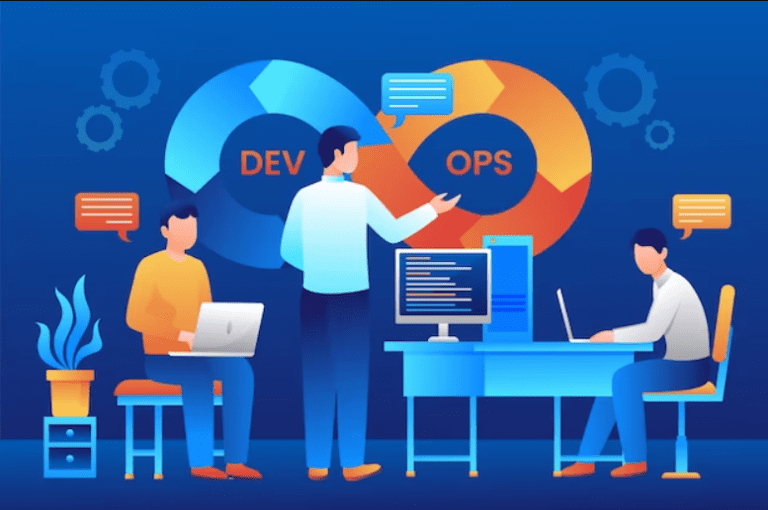How To Integrate DevOps Into Your Software Development Process
DevOps Integration is a critical element of modern software development and delivery processes. It refers to the integration of development and operations teams, tools, and processes to create a more collaborative and efficient software development pipeline.
The integration of these teams helps to break down silos and improve communication, resulting in faster and more reliable software releases.
In earlier times, software development was not as complex as today. Hence, the processes were simpler. You could deliver great products even when working with a waterfall development model just because most of the work was defined and straightforward.
But today, it has changed completely. Nowadays, software development is much more than just creating web apps, having better servers, and providing an awesome user experience is the need of the hour.
Today, there are many competing businesses providing the same set of services. And being better at technology is the only way a business can lead in the market.
DevOps is an approach that everyone should include in their software development process. If you haven't integrated that in your SDLC or don't know about DevOps, this article is going to solve your problems.
Going forward, we will understand what is DevOps and how you can blend it into your development process to reap the best results.
What is DevOps?#

devops-monitoring.jpg
DevOps is a meeting of two words, Development, and Operations. It is an ideology that emphasizes creating cross-functional teams consisting of both developers and members from the operations teams that handle the deployment and testing of the developed products. This approach encourages better communication between various stakeholders of the projects and also assists in faster development and release of products.
Having known about DevOps, let's understand why it is needed.
Why is DevOps Needed?#
The DevOps approach is a much better way to develop software than the age-old waterfall model, where software is deployed at last. Such an approach often leads to miscalculated delivery timelines in case errors occur and also provides much slower releases.
DevOps is needed when product testing is conducted manually at specific intervals, and they keep on failing. In such scenarios, the team cannot move ahead, and DevOps needs to have automated testing in place, which can remove testing dependency significantly.
DevOps is often required to have faster releases in an agile environment.
After knowing why DevOps is needed, you might have understood the importance of adopting this approach, and you'd be looking to integrate it into your development process. Look no further. This next section has a step-by-step process that you can follow to integrate DevOps successfully.
How to Integrate DevOps into Your Software Development Process#

1. Develop a Collaborative Environment within Your Teams#
In earlier times, having dedicated teams would do the work, but things have changed in the development industry. Dedicated teams don't work anymore, and having a collaborative and cross-functional team is needed.
Today you cannot have an entire team of software engineers who just code and build products day in and day out. On the other hand, you can also not have entire teams of testers or operations team members that test and deploy apps into production.
When you have such dedicated teams, there is very little or almost no communication during the development of the product, which is harmful to the output. The primary principle of DevOps is to promote cooperation, and organizations must improve information accessibility and openness.
The disparities between the teams should be strategically intertwined, and businesses should support the proper and reasonable allocation of resources.
2. Have a Budget#
When integrating DevOps, you should not revamp the entire system. As a business, you should have a defined transition strategy and set clear milestones.

A pre-decided budget for DevOps transformation will save on needless costs. Hiring professional developers to enhance your development process with the necessary tech expertise might be one of your methods.
Another option is to upskill your existing staff to ensure that they do not make costly mistakes during the DevOps transformation.
In most cases, when companies adopt DevOps, they often move from on-premise servers to cloud service providers. But before you make such a move, have a quote from different cloud service providers.
3. Establish Clear Communication Among Teams#
You must not only form cross-functional teams but also set them up for clear communication both within and outside the team. There are several technologies available now that can promote real-time communication amongst teams all around the world, and you may utilize them as well.
Create feedback loops and put checks in place to identify and correct communication breakdowns to enhance communications. Reiterate how important efficient communication and teamwork are to you.
4. Change Your Development Approach and Vision#
When incorporating DevOps into your software development methodologies, you must clearly explain the shared objective or vision that guides the work of your teams.
Your aim may always be to have a bug-free launch, to release several production builds every day, or any other goal that is directly tied to your metrics. Remember to bring up the mission regularly. When your teams understand and share the same mission, they will be more productive.
Many companies think that only by adopting DevOps they will get excellent results, but that's not the case. You also need to change the development approach that you follow.
You may not get great results if you end up integrating DevOps in a software project where you are using a waterfall development approach.
5. Include CI/CD Tools#
Continuous Integration and Continuous Delivery tools are at the center of DevOps implementation for all businesses. Such tools provide ways to integrate all builds into a single branch of your code repository, from where it can be sent for testing and deployment. Once the continuous integration tool integrates and creates a build with the latest changes, the automated testing phase begins, and if it goes well, deployment starts.

When you integrate DevOps, you also need to include continuous deployment tools that will deploy your builds automatically on the servers. There are several CI/CD tools in the market, and you need to understand what works well for your environment.
While choosing version control systems, you can have Git, SVN, BitBucket, etc., and if your team has good knowledge of working with Git, you should only choose Git to keep things easy. If you choose CI/CD tools that are not known in the team, you'll also spend significant time training your team for such usage.
Conclusion#
DevOps is a great approach that helps you move faster and build better software products. Today, it is important for every company to integrate DevOps into their software development process.
If you are looking to integrate this approach, we have also discussed a step-by-step approach to doing so; you can follow that and get started with DevOps in your projects.